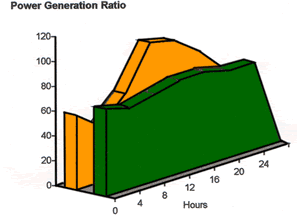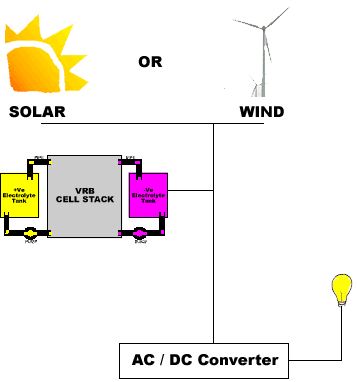
What are the commercial opportunities for VRB?
There is a growing demand worldwide for a reliable and versatile energy storage system. A number of markets in the industrial/commercial energy storage sector are not adequately serviced by existing battery technology. Potential markets cannot be addressed due to the limitations of current traditional industrial batteries. The durability and wide design options available within VRB Technology will allow potential applications to become actual industrial and commercial energy storage markets.
Grid Connected Battery Energy Storage Systems.
A grid refers to an electrical network that distributes electricity to consumers.
Grid connected battery energy storage systems comprise large batteries for specific applications within the electricity utilities sector. Some of these applications include:
Essentially all of the above applications involve the storage of generated or distributed power for use at a required time.
Load leveling and Spinning Reserve control.
Electricity is supplied to the grid by power generators. The source of power can be gas turbines, coal fired generators, hydro driven generators and other forms of energy sources.
Power generators are faced with the difficulty of generating power to meet a variable demand from the grid. The demand for electricity can vary depending on changes in temperature, working hours, changing industrial shifts and holidays etc.
Without an adequate energy storage system, power generators are required to generate more power than is normally required as a reserve against sudden demand. This extra reserve generated is referred to as the spinning reserve. If it is not used and cannot be stored, it is wasted.
Introducing the VRB to this scenario produces an effective and commercial energy storage solution. The power generating utility will have the ability to level the generated output by storing energy in low demand times and using the stored energy at peak demand times. This allows management of sudden demand changes by having stored energy on standby in the VRB. The ability to recover power instantaneously from the VRB allows significant cost savings by reducing the amount of power generated as the spinning reserve. (10% – 15% saving)

With the advances in power electronics and deregulation of electricity markets VRB battery energy storage can provide power generators with a lower cost and environmentally friendly process of providing stable and uninterrupted power to consumers.
Uninterruptible Power Supplies (UPS)
Some power users rely on uninterrupted power (e.g. a hospital with life support systems). A power disturbance or loss of supply from the grid requires an immediate alternate energy source. The operational charge and discharge advantages of the VRB are suited for use in UPS systems. Examples of UPS applications include:
Cost Saving and Power Quality Improvement
Electricity consumers can utilise VRB technology to ensure better power quality and to lower the cost of electricity supply.
Power quality is significant to users of sensitive equipment and continuous supply at a stable voltage is a necessary requirement for many industries and commercial operations. Power supplied from a VRB is not subject to voltage variation or surges from the grid. A VRB can provide regular, high quality supply during periods of power disturbances such as blackouts, voltage dips and frequency variations.
Cost savings are achieved using the VRB by purchasing energy from the grid to charge the battery during off peak times (ie overnight) and using the power stored in the VRB during peak grid price periods.
Telecommunications Backup
Power systems are required to support communication services for subscriber loops, cellular phone towers, exchanges, repeater stations, radio networks and on site customer equipment. Current applications involve using battery energy storage as a power back up to a site that may be grid connected or using a renewable energy source.
The technical and environmental advantages of the VRB make it an attractive consideration for telecommunications applications where the traditional lead acid battery systems are currently widely used.
In remote areas beyond the electricity grid, diesel generators are often used to provide power during long power outages. The VRB has obvious environmental advantages over the diesel generator and does not rely on fuel. A VRB can obtain power from a renewable energy source to provide a reliable reserve of standby power if necessary.
Renewable Energy Storage Systems
Renewable energy such as solar and wind can be converted to electrical energy via photovoltaic cells or turbines when the source (sun or wind) is present.
The value of renewable energy is significantly increased by a battery energy storage system. Using the VRB to efficiently store energy, electricity is available to the end user regardless of when it was generated, providing a reliable supply.
A VRB energy storage system linked to a renewable energy generator can provide stable, high quality power, free from any voltage fluctuations, start up transients and power surges.
This type of energy system is ideally suited to remote locations (ie. where there is no electricity grid) subject to the regular energy source of solar and wind.
The VRB provides an environmentally cleaner alternative to the commonly used diesel generators and larger lead acid batteries.
